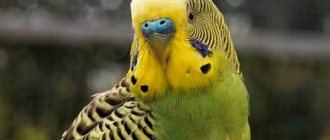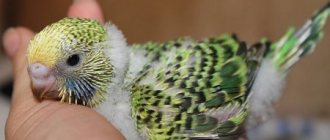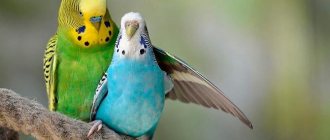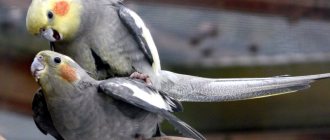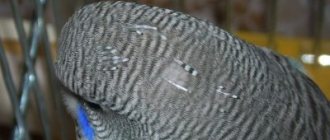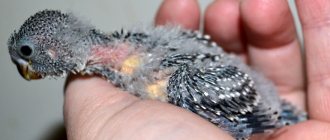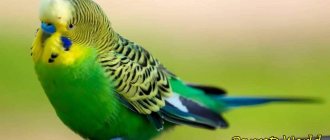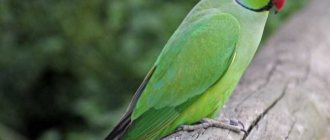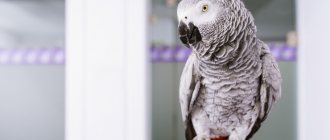Such a natural process as the reproduction of budgerigars at home does not always go well. People who are passionate about breeding cannot do without theory. The breeder must know how to choose a pair of birds and what conditions are required for successful breeding. In addition, you need to be able to care for parrots so that the whole family is healthy. If the owner is ready to go through this difficult path, he can begin equipping the cage.
Preparation for breeding
Breeding budgies at home is a rather complicated, but very interesting and exciting process. It is necessary not only to prepare and equip the home, but also to create comfortable living conditions. If everything is done correctly and you follow the rules of care, then healthy offspring will soon be born.
If the owner is new to this business, it is better to play it safe and find an ornithologist. Arrange for consultations and get his contact information. If something goes wrong or doubts arise, expert advice will be very helpful.
What you will need to breed budgies:
- spacious cage;
- nesting house;
- nesting material;
- an additional cell to transplant offspring.
The optimal cage size for a pair of parrots who will soon become parents is 80 x 40 x 50 cm. The cage should be of such a size that a house can be placed inside without the birds being cramped. During the nesting period, parrots should not be allowed out of their cage. Therefore, it should be quite spacious.
Offspring
Parrot chicks are blind, almost naked or with light down instead of feathers.
Their feeding occurs like this: the parents (at first only the mother) regurgitate food into the small beak of the offspring, all they have to do is swallow.
Chicks have very clearly visible crops. If you adhere to the normal limits, then the crops should be filled with food.
When can you start breeding?
The mating season for budgerigars in nature begins in late spring and lasts until summer. This is the most suitable time for breeding wild parrots, since daylight hours are increased, and food and vitamin supplements are abundant.
You can breed parrots at home at any time of the year. The main thing is to create the necessary conditions for them to do this.
Many breeders are of the opinion that it is better to breed for the same reasons as in nature in the summer. Natural daylight, fresh herbs, freely available vegetables and fruits are very helpful in caring for and maintaining budgies.
It's also worth considering your personal schedule. If problems arise, the owner must have time to provide help and assistance.
Optimal age of parrots for breeding
Males become sexually mature at 10 months. Females are a little later, at 12 months.
The optimal age for mating budgerigars is considered to be from 1.5 to 4 years. At this age, females are more active and mobile, it is much easier for them to bear eggs and care for chicks. Males can participate in breeding for at least 10 years.
Carrying eggs and caring for chicks takes a lot of energy and exhausts the female’s body. Therefore, older females are very weak and can lay unfertilized eggs.
To get healthy offspring, the female is allowed to cross no more than 2 times a year.
Leaving the nest
After three to four weeks (for small parrots) or two to three and a half months (for larger parrots), the chicks leave their parents, leaving the nest. From this moment on, they are able to live an independent life.
But for some time they continue to be fed by an adult couple. If you adhere to a gentle frequency of reproduction, then you will be able to see offspring from your parrots approximately once every two years . And if you take into account the breeding season in relation to large parrots, then even less often. Of course, the more common process of breeding parrots of different species in zoos or in special bird rooms. However, if you wish, no one bothers you, and certainly no one forbids you from breeding feathered comrades in your apartment. It is only necessary to create all the conditions necessary for the successful completion of the planned business. And also provide adequate nutrition for both members of the bird family preparing to become parents.
Conditions of detention
Comfortable conditions for mating are one of the key points when breeding budgerigars at home.
- The first step is to disinfect the cage and accessories.
- Then the daylight hours are increased to 14-16 hours. This must be done gradually, otherwise you can provoke molting.
- The cage should be in a quiet and peaceful place, where there is no noise or extraneous sounds.
- The air temperature should be around 20-23 degrees, air humidity about 60%.
Nutrition
During this period, vitamin and mineral nutrition is extremely important for the parrot. The diet must be rich in nutrients so that the female has the strength to form and carry eggs.
You need to feed parrots not only with a grain mixture. Every day you need to give them greens, fruits, vegetables, cereals and tree branches.
The female's body requires increased nutrition. To form a strong shell, you must include sprouted grains, cottage cheese and eggs in your diet. Foods high in vitamin E are also very beneficial.
Mating season
The male begins to actively court the female. He dances, nods his head, chirps and flaps his wings. If the female accepts courtship, she nods in response, cuddles and rubs with her beak. She can also take part in dancing.
If a couple has formed, then the male begins to take care of the female. He will clean her feathers and feed her. During the mating season, parrots' ceres become bright, rich in color due to hormones.
If a female or male reacts aggressively to each other and fights, they need to be seated. This indicates that the pair did not work out and there will be no mating. In this case, you need to choose another partner.
How does the courtship ceremony take place in birds?
A well-chosen pair exhibits behavior characteristic of displaying birds. The male gently pulls the feathers of his chosen one, making stealing sounds, and often feeds her from his beak.
Parrot courtship ceremony
The friend bows her head favorably in response and sits with half-closed eyelids. Birds kiss regularly and may dance and act in funny ways.
For example, the unusual mating behavior of arar in one of the zoos is described. In addition to the courtship above, the birds took turns lying on their backs, playfully pushing each other with their paws, running around with a nut in their beaks, and trying to take it away from each other.
House installation
2 weeks after the preparation stage, a house must be installed in the cage. The optimal size of the house is 20 x 20 x 15 cm.
Don't worry if the female doesn't react and doesn't go there. In a couple of days she will get used to it, begin to become interested and build a nest there.
For this she will need building material. Sawdust, dry grass and thin twigs are placed in the cage. As a preventive measure against parasites, you can add dry medicinal chamomile.
The female will independently carry the material into the house and arrange the nest; she should not be helped.
Necessary nesting accessories
A special box or nest is installed in the cage.
When choosing an accessory, you need to take into account the type and size of your pets. The height at which the device is suspended depends on these factors. Depending on the design of the cage, it is attached inside or outside.
Nesting accessories required
The sizes of artificially created nests for different species of parrots are shown in the table.
| Parrot species | Diameter of the tap hole or manhole, cm | Internal dimensions, cm | |||
| Nest house | Duplyanka | ||||
| Height, cm | Floor size, cm | Height, cm | Diameter, cm | ||
| Wavy | 5 | 20 | 15x15 | 26 | 16 |
| Lovebird | 6 | 25 | 17x17 | 30 | 17 |
| Flat-tailed | 7 | 35 | 25x25 | 35 | 25-30 |
| Ringed | 8 | 35 | 25x25 | 35 | 20-30 |
| Nandaya, Yendaya and Alexandrian | 9 | 45 | 40x40 | 45 | 40 |
| Small species: cockatoos, amazon and grays | 10 | 70 | 50x50 | 70 | 50 |
| Large species: cockatoo, macaw | 20 | 100 | 70x70 | 100 | 70 |
Preparing to create a nest
Nest houses are made from dry boards, and a nest box is made from a piece of a hollow tree trunk. A hole is made at the bottom for masonry. Its depth is necessary so that the eggs do not roll out and the embryos do not die. The bottom size is needed no smaller than that indicated in the table, otherwise the growing chicks may crush each other.
Dry sawdust is used as bedding. When keeping flocks, the number of devices for breeding birds should be slightly greater than the number of pairs, so that the birds do not fight for space.
Lovebirds build real nests in the wild, so they don’t need a hole in the floor or sawdust. However, several holes with a diameter of 6-8 mm are drilled in the bottom of the box for air circulation.
Laying eggs
A week after mating, the female begins to lay eggs. Laying occurs 1 egg every 1 day.
The number of eggs in a clutch depends on the age and health of the female. Usually there are 4-7 eggs in a clutch. The maximum quantity can reach 12 pieces.
If the female has laid a large number of eggs, then there is a chance that she will not be able to warm them all and the eggs will harden. Then some of the eggs can be given to another couple with a smaller clutch, or an incubator can be used.
Some eggs may not be fertilized. How can this be determined?
- Unfertilized eggs take on a yellowish tint after a few days.
- Fertilized eggs become white-gray or porcelain.
Unfertilized eggs should not be removed from the house; they will serve as a heating pad. But it’s better to remove frozen eggs from the house yourself. Otherwise, the female may mistakenly throw away good eggs.
Why do unfertilized eggs appear?
Usually in one clutch there are always about two unfertilized eggs or even frozen embryos appear. Inexperienced females often warm their testicles unevenly, which leads to slow development.
But if all the offspring die, then this indicates some genetic abnormalities or defects. Often the cause is infectious diseases that the parents have, so you will have to contact a veterinarian.
Unfertilized eggs or frozen embryos often result from the following reasons:
- birds represented by close relatives interbreed;
- the owner does not provide the birds with optimal nutrition;
- poor quality water is offered;
- parents are genetically incompatible with each other;
- incorrect humidity or temperature in the room;
- The bird is too small to hatch.
Eggs will not be fertilized if the breeder has not properly prepared the parrots. But sometimes this indicates the presence of health problems, and this is usually associated with the male.
Fertilization is even affected by the correct location and number of perches inside the cell.
The appearance of chicks
The incubation period lasts 16-20 days. Chicks are born every other day. At this time, it is especially important to maintain air humidity and avoid heat and dryness.
The thing is that under the shell there is a thin film that can dry out in the heat. In this case, the chick will not be able to break it and will die.
At birth, chicks weigh only 1-1.5 grams. They grow and develop quite quickly. If the clutch was large, then when the last chick appears, the first ones are already quite large and can crush the babies.
The chicks are born naked, blind and helpless. They are very weak, cannot support their heads and lie on their backs.
Chick development
The chicks grow very quickly.
- After 6-7 days they open their eyes and can hold their heads up.
- After 9-10 days they have fluff and can sit.
- After 11-12 days, the outline of the pattern appears.
- After 20 days, you can determine the sex of the parrot.
- After 30 days, the chick is almost completely feathered, the tail and wings are still a little short.
2 weeks after leaving the nest, you can begin to remove the young, but only on the condition that they eat on their own.
If the male shows aggression towards the chicks or the female, he should be placed in another cage. But the cages can be placed nearby so that the parrots can communicate.
The process of breeding budgies is quite complex, but very interesting. It is important to carefully prepare for each stage: choose the right pair and create favorable conditions for mating.

